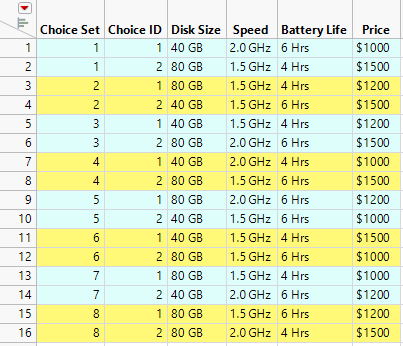Choice Designs
Create a Design for Selecting Preferred Product Profiles
A choice (or discrete choice) experiment provides data for modeling discrete preferences. Study participants are presented with sets of potential products (or product profiles) with varying attributes. From each set of profiles, a participant selects a preferred profile. For example, in designing a high-end laptop, a computer company might be interested in the relative importance of key features such as processor speed, hard disk size, screen size, battery life, and price. A choice experiment addresses the relative values of these features to a customer and indicates an optimal set of trade-offs among product features.
The results of a choice experiment are analyzed using conjoint analysis methods. See “Choice Models” in Consumer Research.
Figure 18.1 A Survey with Eight Choice Sets
